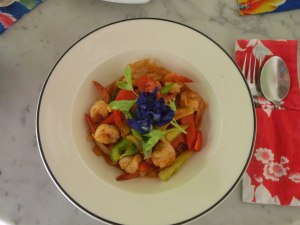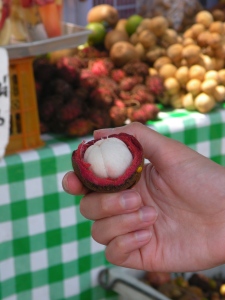Tongue Thai’d
I have had some of my more interesting and delicious meals here in Thailand. An exotic cuisine that is becoming increasingly popular in the US I thought I had an idea about what Thai food would be like when I came here. As a farang (westerner, or foreigner) I have learned far more than I had expected. I’d be wise to add a disclaimer to this list noting that I have what I like to call a “particular palate”. For me this means that I’m not averse to exploring something new on my plate but I would definitely fall into the category of a more “American” eater, sticking to things I know and love best. For lunches in high school I spent years eating Peanut Butter and Jelly sandwiches so I have the tendency to find something I like and cling to it. So food in Thailand has been a rewarding challenge, giving my taste buds a work out and exploring my culinary horizons.
Food here is prevalent and inexpensive and my experience so far with Thai food has been a good one. There are many noodle and rice dishes, accompanied with meat and vegetables. Seafood is prevalent in many dishes and there are fresh prawns that are like the size of small lobsters. I have had some delicious soups, both broth based and coconut based. Most mornings for us have consisted of either a small snack in our room or going to our favorite little coffee shops to order an “American Breakfast” of eggs and toast. Lunches and dinners are the meals where I have tried to eat a more Thai style meal. Funnily enough we came upon a really good Indian restaurant while in Nai Yang and that is another food that I am unfamiliar with but through this trip have grown to love. We had our last meal in Nai Yang there and the owner was so pleased that I have become a convert. There are a couple of “myths” I’ve already debunked on this trip and I’m sure as we finish our journey here in Chiang Mai I’ll discover much more.

Myth #1: Chop Sticks
I was under the impression that since I was going to an Asian country I would be eating with chopsticks constantly. Unlike most of its neighbors Thailand has become more westernized at the dinner table with its cutlery. Almost all meals are served with a fork and spoon. Some hotels and restaurants in tourist areas also seem to cater to their guests by including a knife but because most Thai food is already cut into smaller pieces so you rarely need it. I prefer to believe the more romantic version of the story, which is the legend that one of the Kings (I’ve read it was Rama V) was credited for modernizing Thailand and after having British diplomats over for dinner it influenced him to a new way of eating. It is also rumored that he believed knives were meant as weapons and had no place at the table.

Myth #2: Spicy, Spicier and Spiciest
Don’t get me wrong, the Thai love spicy foods, and if you are a lover of all things hot this style of cooking will be just right for you. It has been my experience that most places are accommodating to all taste buds and will alter the level of spice for you. There are other options for us mild food lovers, and a good Thai meal will incorporate sweet, salty and sour in addition to the spice. Every country has their different styles when it comes to food and I have been lucky to get to experience new things here with people that have traveled and lived in Thailand. Much like a family style meal food is ordered for the table and then shared. Traditionally one person will order for the table and will usually include a nice variety of foods. I’ve been spoiled this way because it has given me the opportunity to try small servings of a myriad of dishes.
Thai food has been influenced by Chinese, Indian and even Portuguese and this accounts for its unique variety of herbs and spices that create such signature flavors. Between the sixth and thirteenth centuries people migrated from the mountains of Southwest China and sprinkled down into what is now Thailand, Laos, Vietnam and Myanmar. This helped to infuse Chinese style cooking techniques in Thai food. In the seventeenth century they began an interest in foreign trade with Portugal and by the eighteenth century spices from India were introduced which influenced use of curry in Thai food. You are sure to find the complex flavors of Massaman, yellow, green and other curries on any menu.

Myth #3 Clean plate club
This is simple and stupid but I made the mistake of doing this even after hearing a story from another traveler. Particularly with the Thai soups (like the famous Tom Yum Goong) there are ingredients added to enhance the flavor but you don’t necessarily have to consume all of it. In typical American fashion I wanted to finish my dish and found myself gnawing on a lime leaf. Similar to a Bay Leaf, all leaves or lemongrass stalks and small (probably hot!) chilis can all be left at the bottom of the bowl.
Myth #4 I’ll never see a cheeseburger AGAIN
I know when you travel to a foreign country, especially one that is rich in culture and has amazing cuisine; you should immerse yourself in it and try as many new things as possible. I’m all for that philosophy but I’m going to be honest and say I also have a hankering for a burger and fries on occasion. I’m happy to report that I didn’t see a McDonalds or Starbucks until well into the middle of my trip when we came to the bigger cities and that was really refreshing. Even without the western food and coffee chains the small beach restaurants have foods like pizza or fries on the menu if one day you aren’t feeling that adventurous. The minimarts (7-11 is all over the place here) also have little familiar snacks and I’m guilty of buying a can (or two) of Pringles when my stomach gets a little homesick. Trying to be open to new things and experiences is one of the reasons I thrive on travel and I think it’s a challenge not only for myself but also for others to move outside of your comfort zone where you can grow. So, if that means tasting amazing new foods in the process, than that is a challenge I’m willing to accept.



